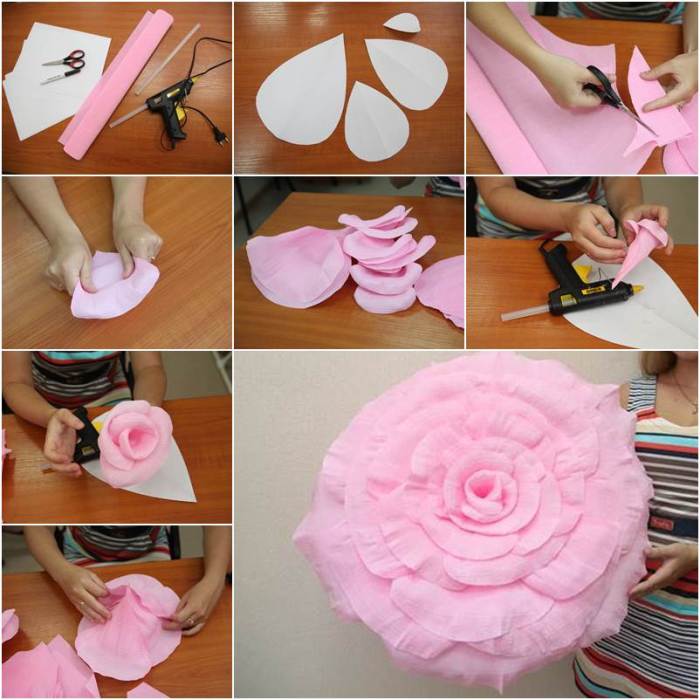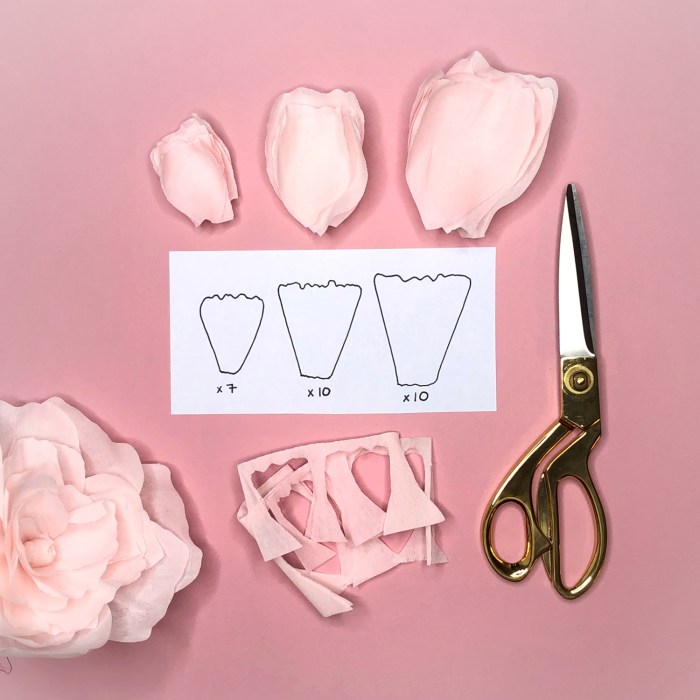Crepe paper flowers DIY sets the stage for a captivating journey into the world of crafting stunning, lifelike blooms. This versatile material offers a wealth of possibilities for creating beautiful and unique flower arrangements, whether for special occasions, home décor, or simply to add a touch of nature’s beauty to your surroundings.
From basic techniques to advanced projects, this guide will provide you with the knowledge and inspiration to create stunning crepe paper flowers that will impress your friends and family.
Inspiring Crepe Paper Flower Designs: Crepe Paper Flowers Diy

Crepe paper flowers are a versatile and beautiful craft that can be used to decorate everything from weddings and parties to home decor. With a little creativity and imagination, you can create stunning flowers that look almost real.
The beauty of crepe paper flowers lies in their endless possibilities. From delicate roses to bold sunflowers, the range of designs is limited only by your imagination. The texture of crepe paper allows for intricate details, and its flexibility makes it easy to shape and mold into different forms.
A Gallery of Crepe Paper Flower Designs
Here are some inspiring examples of crepe paper flower designs that showcase the diversity and beauty of this craft:
- Roses: Roses are a classic choice for crepe paper flowers. They can be made in a variety of colors and sizes, and the petals can be curled and layered to create a realistic look. You can even experiment with different techniques, such as using wire to create stems or adding glitter for a touch of sparkle.
- Peonies: Peonies are known for their large, fluffy blooms, and they can be beautifully recreated using crepe paper. The key to creating realistic peonies is to use multiple layers of petals and to create a sense of depth and dimension. You can also use different colors and textures of crepe paper to add variety to your peonies.
- Sunflowers: Sunflowers are a cheerful and vibrant flower that can brighten up any space. To create a sunflower, you’ll need to use yellow crepe paper for the petals and brown crepe paper for the center. You can then add details like a black center and green leaves to complete the look.
- Dahlias: Dahlias are a complex flower with many layers of petals. Crepe paper is an ideal material for creating dahlias, as it allows you to create intricate details and textures. You can experiment with different colors and patterns to create unique and eye-catching dahlias.
- Calla Lilies: Calla lilies are known for their elegant and simple beauty. To create a calla lily, you’ll need to use a single piece of crepe paper and fold it into a cone shape. You can then use a wire to create a stem and add details like a stamen to complete the look.
Tips for Creating Beautiful Crepe Paper Flowers, Crepe paper flowers diy
- Choose the right crepe paper: Crepe paper comes in a variety of weights and textures. For delicate flowers, choose a lighter weight crepe paper. For bolder flowers, choose a heavier weight crepe paper.
- Use wire for stems: Wire is a great way to create sturdy stems for your crepe paper flowers. You can use floral wire or even thin craft wire.
- Experiment with different techniques: There are many different techniques that you can use to create crepe paper flowers. Don’t be afraid to experiment and find what works best for you.
- Add details: Details like glitter, sequins, and beads can add a touch of sparkle and personality to your crepe paper flowers.
Troubleshooting and Tips

Creating crepe paper flowers can be a rewarding experience, but it also presents its own set of challenges. From uneven petals to fragile blooms, there are common hurdles that you might encounter. This section will equip you with solutions to overcome these obstacles and elevate your flower-making skills.
Common Challenges and Solutions
Troubleshooting is a crucial part of any craft project, and crepe paper flowers are no exception. This section explores some common challenges you might face and provides solutions to ensure your floral creations are as beautiful as they can be.
- Uneven Petals: One of the most frequent problems is creating petals that are uneven in size or shape. This can be caused by inconsistent cutting, stretching, or shaping techniques. To prevent this, ensure you use a sharp pair of scissors for precise cuts and practice consistent stretching and shaping techniques. Employ a ruler or template for uniform petal sizes.
- Fragile Blooms: Crepe paper flowers can be delicate, especially when using thin paper. This can lead to fragile blooms that are prone to damage. To address this, consider using a thicker crepe paper variety, or reinforce the flower’s structure with a wire frame or a sturdy center. Apply a light layer of glue to the base of petals or to areas where the flower needs extra support.
- Creasing and Wrinkling: Crepe paper is prone to creasing and wrinkling, especially when handling it frequently. These imperfections can detract from the flower’s appearance. To minimize creasing, handle the paper gently, and avoid excessive folding or bending. Use a light touch when shaping petals, and store finished flowers in a cool, dry place to prevent further damage.
- Color Bleeding: If you’re using colored crepe paper, color bleeding can occur, especially when working with darker shades. To prevent this, test the paper for colorfastness before using it for your flower project. Use a water-based sealant or a thin layer of clear acrylic paint to seal the paper and prevent bleeding.
- Difficult Shaping: Shaping petals can be tricky, especially for complex flower designs. This is where patience and practice come into play. Experiment with different shaping techniques, like using a curling iron, a straw, or your fingers. Watch videos and tutorials for guidance and inspiration.
Tips for Achieving Realistic Results
Realistic crepe paper flowers require attention to detail and a good understanding of flower anatomy. This section provides valuable tips for achieving lifelike results in your creations.
- Study Real Flowers: Before you start crafting, take the time to observe real flowers. Pay attention to their shape, petal arrangement, and color variations. This will help you understand the intricacies of flower anatomy and translate them into your crepe paper creations.
- Layer Petals: Layering petals adds depth and dimension to your flowers. Start with the largest petals at the base and work your way up to smaller petals towards the center. Use different shades of crepe paper to create subtle color transitions and add realism.
- Create Texture and Detail: Use tools like a curling iron, a straw, or even your fingers to create realistic texture and detail in your petals. Gently curl the edges, create veins, and add imperfections for a more natural look.
- Use Multiple Colors: Don’t be afraid to use multiple colors to create a more realistic look. Use shades of the same color for depth, or experiment with contrasting colors for a unique and eye-catching effect.
- Add Finishing Touches: Small details can make a big difference. Consider adding a few stamens, a stem, or a touch of glitter to enhance the realism of your flower.
Tips for Ensuring Durability
Crepe paper flowers are delicate, but with proper care, they can last for years. This section shares tips for creating durable flowers that can withstand the test of time.
- Use a Sturdy Wire Frame: For larger flowers or those that need extra support, use a wire frame as the foundation. This will provide a strong structure and prevent the flower from collapsing.
- Apply Glue Sparingly: Use glue sparingly to avoid making the flower stiff or heavy. Focus on securing petals at the base or in areas where extra support is needed.
- Use a Water-Based Sealant: A water-based sealant can help protect the crepe paper from moisture and prevent color bleeding. Apply a thin layer to the finished flower to create a protective barrier.
- Handle with Care: Once your flowers are complete, handle them with care to prevent damage. Avoid excessive bending or twisting, and store them in a cool, dry place.
Tips for Preventing Damage
With proper care, your crepe paper flowers can retain their beauty for a long time. Here are some tips to prevent damage to your delicate creations.
- Avoid Direct Sunlight: Direct sunlight can fade the colors of crepe paper. Store your flowers in a cool, dry place, away from direct sunlight.
- Avoid Moisture: Crepe paper is susceptible to moisture. Keep your flowers away from humid environments and avoid getting them wet.
- Dust Regularly: Dust can accumulate on crepe paper flowers, making them look dull. Use a soft brush or a feather duster to remove dust regularly.
Resources for Further Learning and Inspiration
There’s a vast world of crepe paper flower artistry to explore. This section provides resources to fuel your creativity and take your flower-making skills to the next level.
- Books: “The Complete Book of Crepe Paper Flowers” by Susan Denniston and “Crepe Paper Flowers: Techniques and Designs” by Debbie Macomber are excellent resources for learning techniques and finding inspiration.
- Websites: Websites like “Crepe Paper Flowers” and “The Flower Patch” offer a wealth of tutorials, patterns, and inspiration.
- Online Tutorials: YouTube is a treasure trove of crepe paper flower tutorials. Search for specific flower types or techniques to find step-by-step instructions from experienced crafters.
Crepe Paper Flower Sustainability

Crepe paper flowers are a delightful and eco-friendly craft project. Unlike real flowers, crepe paper is biodegradable, making it a sustainable choice for floral decorations. Let’s delve into the environmental benefits of using crepe paper and discover ways to make your crafting even greener.
Repurposing and Recycling Crepe Paper Scraps
Repurposing and recycling crepe paper scraps can significantly reduce waste and contribute to a more sustainable crafting practice.
- Create smaller flowers: Use leftover crepe paper scraps to make tiny flowers, embellishments, or even confetti. This allows you to utilize every bit of material.
- Make paper chains: Crepe paper scraps can be easily cut into strips and linked together to create colorful paper chains for decorations or festive garlands.
- Craft gift wrapping: Turn crepe paper scraps into unique gift wrapping paper by gluing them onto recycled paper or cardboard. Add ribbons and embellishments for a personalized touch.
Exploring Sustainable Practices
Beyond crepe paper, consider these sustainable practices for your flower crafting:
- Use recycled materials: Incorporate recycled paper, cardboard, or even fabric scraps into your flower designs for a unique and eco-friendly touch.
- Choose eco-friendly glue: Opt for non-toxic and biodegradable glues to minimize the environmental impact of your crafting materials.
- Support sustainable suppliers: Look for crepe paper and crafting materials from companies committed to sustainable practices, such as using recycled materials or minimizing their carbon footprint.
The art of crafting crepe paper flowers is a rewarding experience that allows you to unleash your creativity and bring a touch of elegance to any setting. With a little practice and patience, you can create stunning arrangements that will add a unique and personal touch to your home, events, and gifts. So, gather your supplies, embrace your creativity, and embark on this exciting journey of crafting beautiful crepe paper flowers.
Crafting crepe paper flowers is a delightful way to add a touch of handmade beauty to your home. It’s a fun and relaxing activity that can be enjoyed by people of all ages. If you’re looking for a way to add some color and cheer to your space, consider making some crepe paper flowers. For those with skin conditions like eczema, there are also helpful treatments available, such as Dupixent , which can provide relief and improve quality of life.
Once you’ve finished crafting your flowers, you can display them proudly in your home or give them as thoughtful gifts.
